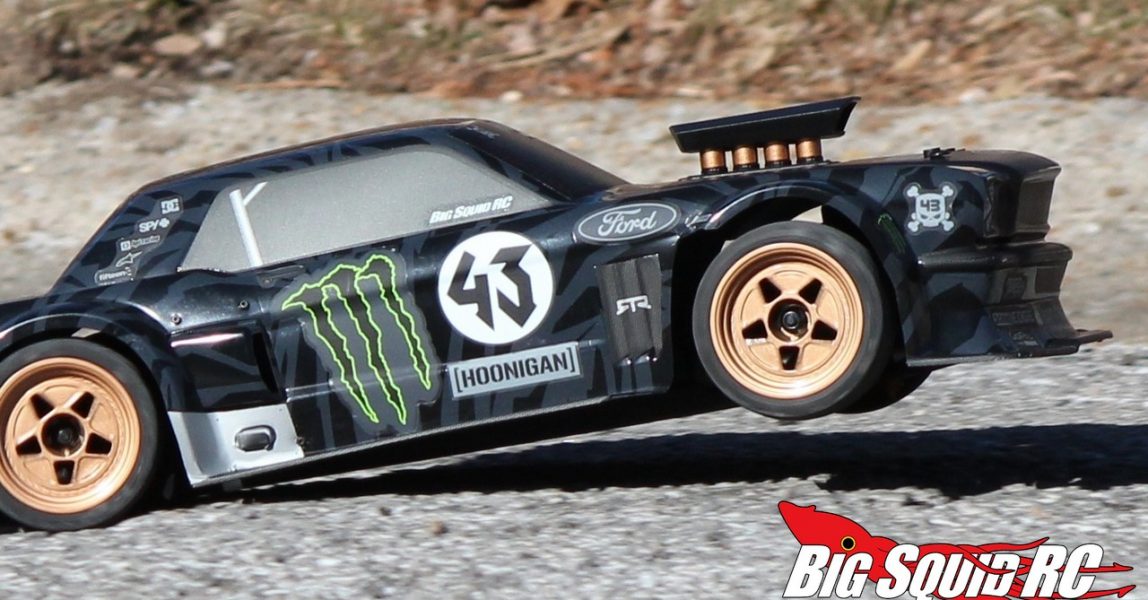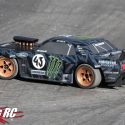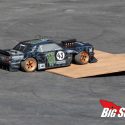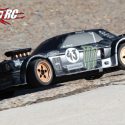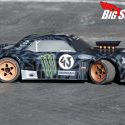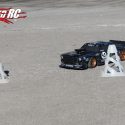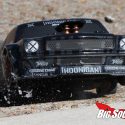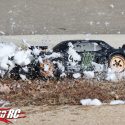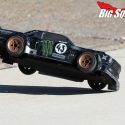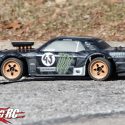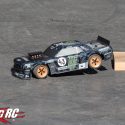From the first time we saw the HPI Racing Ken Block Hoonicorn we were amazed by how it looked. Not only is it a great representation of Block’s full sized car, but it also comes on HPI’s RS4 Sport 3 chassis. After receiving a test unit, we’ve been bashing it non-stop. How well does it hold up? How easy is it to drift? How many people got whiplash when seeing it for the first time? Read on to find out…
From: HPI Racing
Direct Link: Ken Block Hoonicorn
Unboxing Pictures: BSRC Unboxes The Hoonicorn
Review By: Cubby
Photography By: Tim Mohr
Specs:
RTR or Kit: RTR
Age: 14+
2wd or 4wd: 4wd
Shaft or Belt: Shaft
Electric or Gas: Electric
Waterproof: Yes
Scale: 1/10
Length: 17″
Width: 7.9″ (200mm)
Wheelbase: 10″
Motor: Firebolt 15 turn brushed
Speed Controller: Brushed, waterproof
Low Voltage Cut-off: Yes
Radio: TF-40 2.4GHz
Differential: Gear type
Slipper Clutch: No
Driveshafts: Metal bones
Shocks: Plastic, oil filled
Servo Saver: On servo output
Screws: Metric, hex
Bearings: Yes
Tires: HPI, scale realistic
Battery: 7.2v 2000mAh NiMH
Part Number: #115990
Warranty: Two year component warranty
Bashing Specs:
Front wheel travel: .75″
Rear wheel travel: .70″
Wheelie on demand: No
Backflip off ramps: No
Stability Control: No
Sound Module: No
Self-Righting: No
FPV: No
Top Speed (measured by BSRC on 2S 5250 LiPo): 22 mph
Runtime (measured by BSRC on 2S 5250 LiPo): 26 minutes
Street Price: $289
Primary Competition: There are some pretty cool RTR tenth scale touring cars on the market, as well as drift versions. So put Associated, Kyosho, etc, down as just some of the Hoonicorn’s competition.
What’s Needed To Complete: Nothing! Every single thing you need to drive comes right in the box.
Build Quality: After passing the car around the room, we found the assembly quality to be fine. One of the shocks was a bit low on oil, and the servo saver was adjusted a bit tight, but otherwise the car was fine.
Test Drivers: Hawaiian Chris, Robbie G., Iron Mikeee, T-$$$, and yours truly.
Test Venues: We drove the HPI at 3 local parks. All three parks had plenty of pavement, as well as grassy areas, etc.
Set-up Notes: We ran the chassis and radio bone stock, but did elect to slip in some high-amperage LiPo batteries from Maxamps to make sure the Hoonicorn had maximum rip. Charging was handled by a Hitec X1 Pro charger.
Turning: It really is all about the corners with the Hoonicorn. You see, while it has rubber tires, it really is set up as a drifter. Going into a typical corner the front end would stick quite well, while the rear would be quite loose. At least that’s how it was when attacking corners in a “normal” style. However, when you elected to drift a corner, that loose rear end seemed to track much better. The Hoonicorn simply loves to drift and we felt like it did a solid job of drifting in a bashing environment.
Jumping: We didn’t do a bunch of huge jumps with the Hoonicorn as we knew how that was going to turn out. What we did do was build some small ramps, plus he hit some rounded curbs to check out its airtime capabilities. And no, you don’t want to get more than a few inches of air with it. While it did fine over “scale” sized jumps, it just doesn’t have enough suspension travel to catch big air.
Bumps/Whoops: No, we didn’t hit any 80 foot long whoop sections at the local track to test the HPI, we judged its bump handling ability based on what we found in normal street driving. With all that said, we found the car soaked up normal road joints and small potholes just fine. We were driving it hard and hitting every pot hole we could. Afterwards, we all agreed that its suspension was definitely in the ballpark for the type of rough sections that you find out on real world streets.
On-Road: Like stated above in the turning section, the Hoonicorn loves to drift. If you are looking to drive the Hoonicorn in a “normal” manner, it will take a change of tires to get more grip. If you are buying it for drift action, you will be dialed, at least for street style drifting.
Grass: Yup, we tried it. Nope, you don’t want to.
Tires: The stock tires aren’t super hard for rubber, nor are they super soft. However, we did find that because we were drifting 80% of the time with the car, that the tires wore fairly quickly. Are the stock tires a good pick? Yes, we think so. They aren’t so hard as to make it a 100% drift car, but not so soft that drifting isn’t possible. They are a nice mix between the two.
Power: The gearing tops the brushed powered Hoonicorn out to about 22 mph. Stock the power isn’t crazy, but it has enough yank to get the job done. A weaker system would have had a harder time keeping the tires spinning during a drift, our unit running off LiPo seemed to have more than adequate power for what the car was intended for. The stock power system on LiPo had no problem keeping the tires spinning during a drift, even on rough (higher traction) pavement.
Radio: No complaints from us about the TF-40. It has a serrated trigger, a slightly drop-down wheel, and we never had an issue with range or glitching.
Broken Parts: The plastic parts on the Hoonicorn are molded from plastic that is quite soft. Combine that with a relatively low top speed, and we found the Hoonicorn quite hard to break. Our drivers slammed it into various hard objects and it simply survived, time after time. Eventually, an especially hard curb shot broke the first part, which turned out to be one of the front hub carriers.
Misc Notes:
Wow, the Hoonicorn is one gnarly looking car. Seriously, even if you aren’t into the on-road scene, it has been pretty awesome just having the car around the office to show off.
Yes, the stock multi-piece body is hot looking, but it is also highly detailed. The full sized Hoonicorn has a bunch of things that make it look different than any other car, HPI did a fantastic job of making sure those details made it to the rc version.
Stock, the car comes with Tamiya style connectors. While not a very good connector, at least we already had plenty of batteries laying around with the same connector that we could use in the car.
What about that stock servo? We never noticed it. That is a good thing.
We liked the RS4 Sport 3 chassis. It is logically laid out. It is easy enough to work on. Plus, it drove well and held up like a beast.
Best Mod: Tires! We would either bolt on more traction and go for normal/general driving, or drop on some Firebrand RC drift tires and go do some hardcore drifting.
Summary:
A = Outstanding/Best in Class, B = Above Average, C = Average, D = Below Average, F = Horrific
Time To Bash: A Thanks to everything coming right in the box we had to give the Hoonicorn an “A” in the time to bash category.
Workability: B Wrenching on the Hoonicorn was easy and generally a pleasant experience.
Car Show Rating: A We know we have been posting some “A” scores in car show rating lately, but Damn! The Hoonicorn is one ridiculously hot looking car. Even the wheels are tires are perfect! In all our years of testing, we have never had so many people come over to check out an on-road car before.
Bash-A-Bility: B We found the plastic on the HPI to be quite soft, perfect for bashing. We beat on our test unit for weeks with very few broken parts to show for it.
Fun Factor: A If you are into the drift scene, or the Ken Block scene, the Hoonicorn is awesome fun. It looks just like the real deal, plus it drives really well for its intended use of drifting around parking lots.
Handling: B Speaking of driving, we were impressed by the handling characteristics of the Hoonicorn. It loved to drift and did so in a fairly controllable manner. Even first time drivers were able to lay down some impressive drifts with the Hoonicorn.
Value: B The Hoonicorn comes in at $289, a price we feel is a solid value for the car/amount of fun that you get in return.
Parts Availability: C While we couldn’t find parts at our local hobby shops, we easily found them on-line.
BigSquid Rating: B+ We can absolutely recommend the HPI Ken Block Hoonicorn RS4 Sport 3 to you! The Hoonicorn held up like a champ, plus our test crew had hours upon hours of fun with it.

